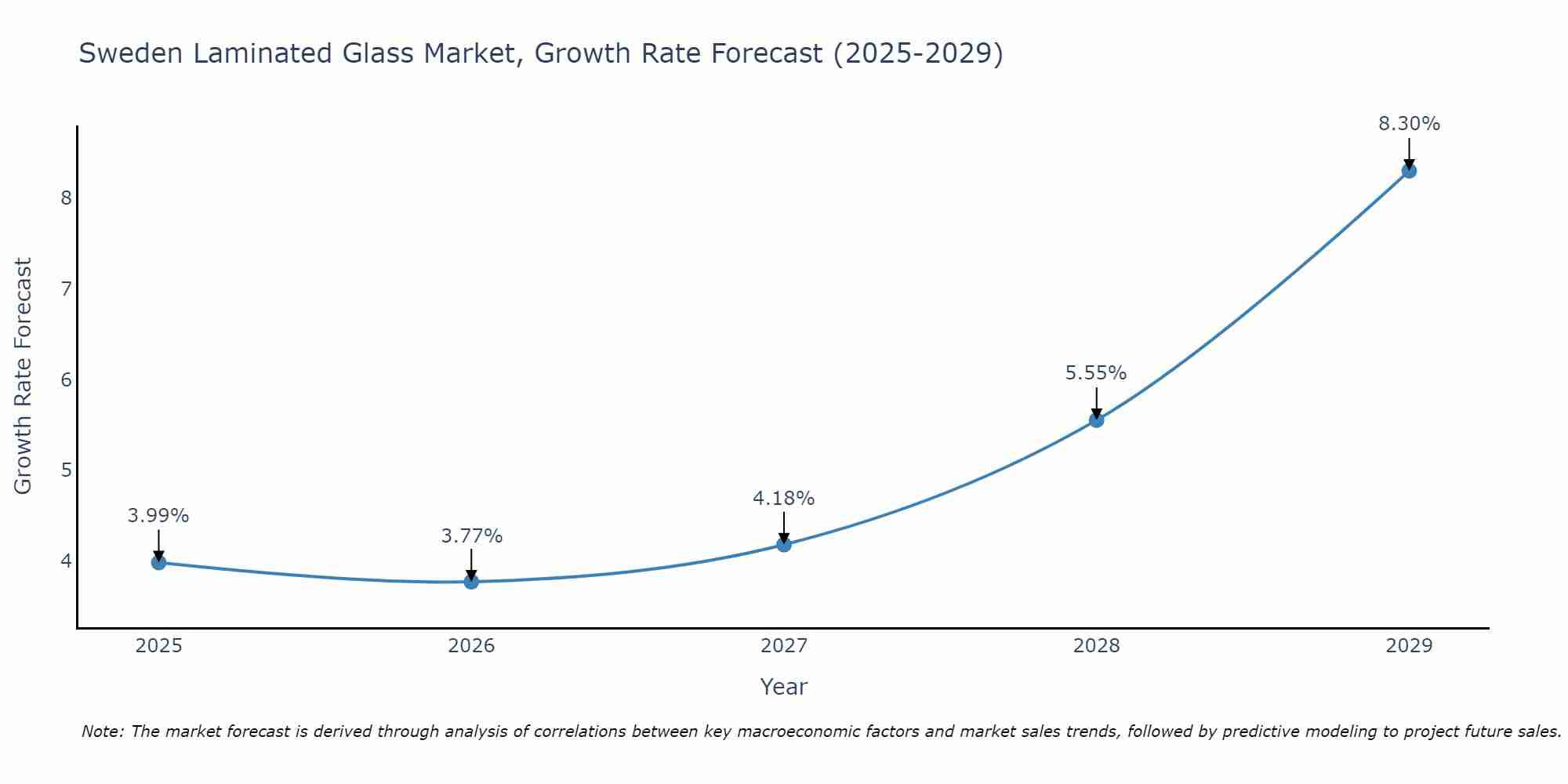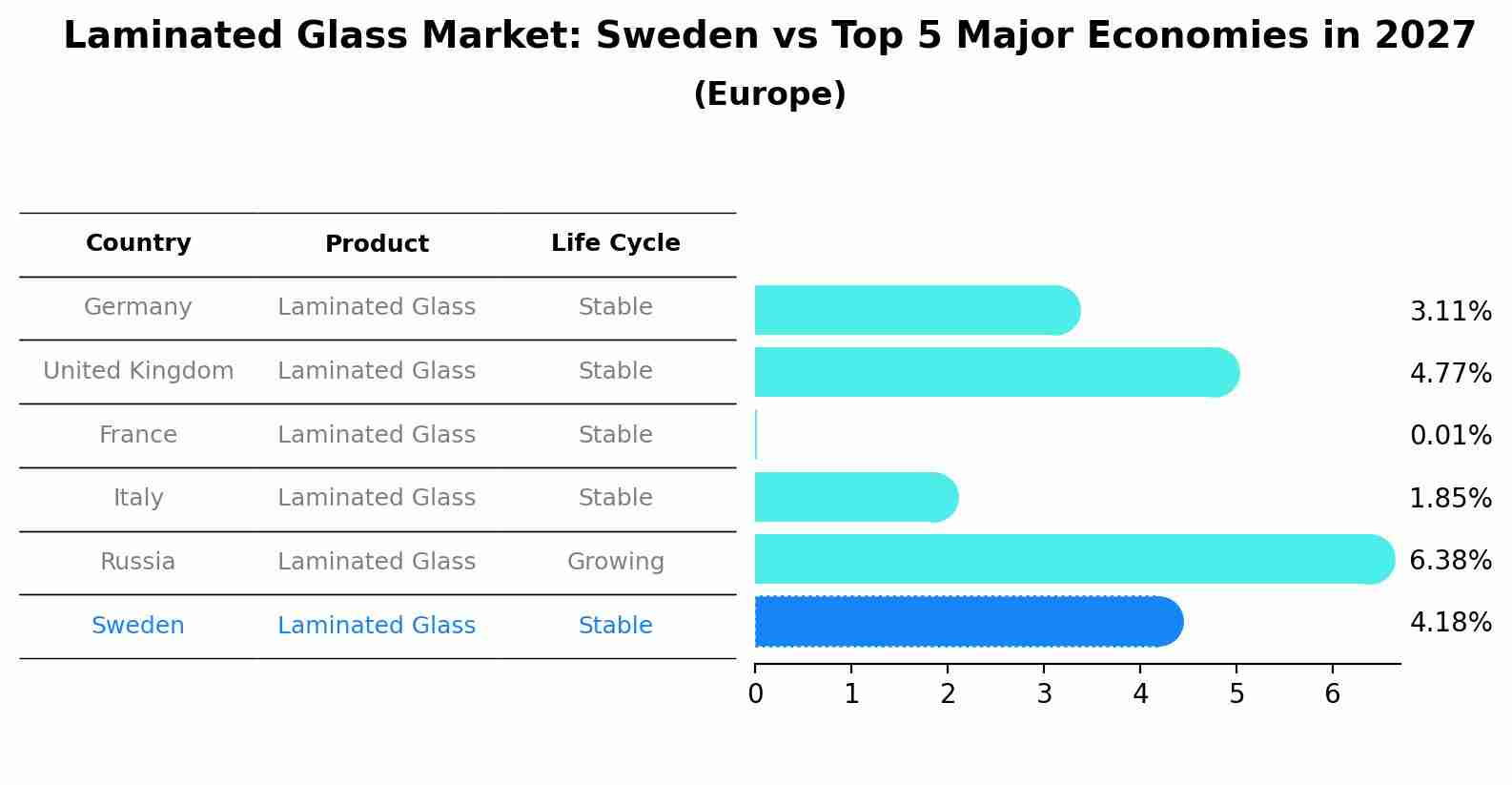Sweden Laminated Glass Market (2025-2031) | Analysis, Value, Segmentation, Revenue, Outlook, Forecast, Industry, Share, Size, Growth, Trends & Companies
| Product Code: ETC4912463 | Publication Date: Nov 2023 | Updated Date: Sep 2025 | Product Type: Market Research Report | |
| Publisher: 6Wresearch | Author: Sachin Kumar Rai | No. of Pages: 60 | No. of Figures: 30 | No. of Tables: 5 |
Sweden Laminated Glass Market Size Growth Rate
The Sweden Laminated Glass Market is projected to witness mixed growth rate patterns during 2025 to 2029. Commencing at 3.99% in 2025, growth builds up to 8.30% by 2029.

Laminated Glass Market: Sweden vs Top 5 Major Economies in 2027 (Europe)
Sweden's Laminated Glass market is anticipated to experience a stable growth rate of 4.18% by 2027, reflecting trends observed in the largest economy Germany, followed by United Kingdom, France, Italy and Russia.

Sweden Laminated Glass Market Overview
The laminated glass market in Sweden is growing as the demand for safety and security glass products increases. Laminated glass is widely used in automotive, construction, and architectural applications due to its enhanced strength and safety features. The emphasis on energy-efficient and environmentally friendly building solutions further supports market growth, as laminated glass offers insulation properties and sound reduction. Additionally, advancements in manufacturing techniques and the introduction of new designs cater to evolving consumer preferences. The increasing focus on sustainable building materials aligns with the market trends, driving demand for laminated glass solutions.
Drivers of the market
The laminated glass market in Sweden is primarily driven by the increasing demand for safety and security in construction and automotive applications. The rise in building and construction activities, along with the growing awareness of energy efficiency and sound insulation, propels the adoption of laminated glass products. Furthermore, the expansion of the automotive sector, with a focus on passenger safety, enhances the demand for laminated glass in vehicle manufacturing.
Challenges of the market
The laminated glass market in Sweden faces challenges related to consumer awareness and market differentiation. While laminated glass offers superior safety and security features, many consumers remain unaware of its benefits compared to traditional glass options. This lack of awareness can hinder market growth, requiring manufacturers to invest in educational marketing strategies to promote the advantages of laminated glass. Furthermore, the market is characterized by significant competition, with various manufacturers offering similar products, leading to price sensitivity and potential challenges in maintaining profitability.
Government Policy of the market
In Sweden, the laminated glass market is influenced by government policies that prioritize safety, energy efficiency, and sustainability. Regulations mandate the use of laminated glass in construction and automotive applications to enhance safety and security. The government supports initiatives aimed at promoting energy-efficient building practices, encouraging the use of laminated glass for thermal insulation. Additionally, policies promote recycling and sustainable practices in laminated glass manufacturing.
Key Highlights of the Report:
- Sweden Laminated Glass Market Outlook
- Market Size of Sweden Laminated Glass Market, 2024
- Forecast of Sweden Laminated Glass Market, 2031
- Historical Data and Forecast of Sweden Laminated Glass Revenues & Volume for the Period 2021-2031
- Sweden Laminated Glass Market Trend Evolution
- Sweden Laminated Glass Market Drivers and Challenges
- Sweden Laminated Glass Price Trends
- Sweden Laminated Glass Porter`s Five Forces
- Sweden Laminated Glass Industry Life Cycle
- Historical Data and Forecast of Sweden Laminated Glass Market Revenues & Volume By Type for the Period 2021-2031
- Historical Data and Forecast of Sweden Laminated Glass Market Revenues & Volume By Polyvinyl Butyral (PVB) for the Period 2021-2031
- Historical Data and Forecast of Sweden Laminated Glass Market Revenues & Volume By Sentryglas Plus (SGP) for the Period 2021-2031
- Historical Data and Forecast of Sweden Laminated Glass Market Revenues & Volume By Ethylene-vinyl Acetate (EVA) for the Period 2021-2031
- Historical Data and Forecast of Sweden Laminated Glass Market Revenues & Volume By Other Types for the Period 2021-2031
- Historical Data and Forecast of Sweden Laminated Glass Market Revenues & Volume By End-user Industry for the Period 2021-2031
- Historical Data and Forecast of Sweden Laminated Glass Market Revenues & Volume By Automotive for the Period 2021-2031
- Historical Data and Forecast of Sweden Laminated Glass Market Revenues & Volume By Building and Construction for the Period 2021-2031
- Historical Data and Forecast of Sweden Laminated Glass Market Revenues & Volume By Electronics for the Period 2021-2031
- Historical Data and Forecast of Sweden Laminated Glass Market Revenues & Volume By Other End-user Industries for the Period 2021-2031
- Sweden Laminated Glass Import Export Trade Statistics
- Market Opportunity Assessment By Type
- Market Opportunity Assessment By End-user Industry
- Sweden Laminated Glass Top Companies Market Share
- Sweden Laminated Glass Competitive Benchmarking By Technical and Operational Parameters
- Sweden Laminated Glass Company Profiles
- Sweden Laminated Glass Key Strategic Recommendations
Frequently Asked Questions About the Market Study (FAQs):
1 Executive Summary |
2 Introduction |
2.1 Key Highlights of the Report |
2.2 Report Description |
2.3 Market Scope & Segmentation |
2.4 Research Methodology |
2.5 Assumptions |
3 Sweden Laminated Glass Market Overview |
3.1 Sweden Country Macro Economic Indicators |
3.2 Sweden Laminated Glass Market Revenues & Volume, 2021 & 2031F |
3.3 Sweden Laminated Glass Market - Industry Life Cycle |
3.4 Sweden Laminated Glass Market - Porter's Five Forces |
3.5 Sweden Laminated Glass Market Revenues & Volume Share, By Type, 2021 & 2031F |
3.6 Sweden Laminated Glass Market Revenues & Volume Share, By End-user Industry, 2021 & 2031F |
4 Sweden Laminated Glass Market Dynamics |
4.1 Impact Analysis |
4.2 Market Drivers |
4.2.1 Increasing demand for energy-efficient buildings and infrastructure projects in Sweden. |
4.2.2 Stringent safety regulations and building codes promoting the use of laminated glass. |
4.2.3 Growing trend towards sustainable and eco-friendly construction materials. |
4.3 Market Restraints |
4.3.1 High initial costs associated with laminated glass installation and manufacturing. |
4.3.2 Competition from alternative materials such as tempered glass or polycarbonate. |
4.3.3 Fluctuations in raw material prices impacting the overall production costs. |
5 Sweden Laminated Glass Market Trends |
6 Sweden Laminated Glass Market Segmentations |
6.1 Sweden Laminated Glass Market, By Type |
6.1.1 Overview and Analysis |
6.1.2 Sweden Laminated Glass Market Revenues & Volume, By Polyvinyl Butyral (PVB), 2021-2031F |
6.1.3 Sweden Laminated Glass Market Revenues & Volume, By Sentryglas Plus (SGP), 2021-2031F |
6.1.4 Sweden Laminated Glass Market Revenues & Volume, By Ethylene-vinyl Acetate (EVA), 2021-2031F |
6.1.5 Sweden Laminated Glass Market Revenues & Volume, By Other Types, 2021-2031F |
6.2 Sweden Laminated Glass Market, By End-user Industry |
6.2.1 Overview and Analysis |
6.2.2 Sweden Laminated Glass Market Revenues & Volume, By Automotive, 2021-2031F |
6.2.3 Sweden Laminated Glass Market Revenues & Volume, By Building and Construction, 2021-2031F |
6.2.4 Sweden Laminated Glass Market Revenues & Volume, By Electronics, 2021-2031F |
6.2.5 Sweden Laminated Glass Market Revenues & Volume, By Other End-user Industries, 2021-2031F |
7 Sweden Laminated Glass Market Import-Export Trade Statistics |
7.1 Sweden Laminated Glass Market Export to Major Countries |
7.2 Sweden Laminated Glass Market Imports from Major Countries |
8 Sweden Laminated Glass Market Key Performance Indicators |
8.1 Energy efficiency ratings of buildings using laminated glass. |
8.2 Number of new construction projects opting for laminated glass solutions. |
8.3 Environmental impact assessments showcasing the benefits of laminated glass in reducing carbon footprint. |
9 Sweden Laminated Glass Market - Opportunity Assessment |
9.1 Sweden Laminated Glass Market Opportunity Assessment, By Type, 2021 & 2031F |
9.2 Sweden Laminated Glass Market Opportunity Assessment, By End-user Industry, 2021 & 2031F |
10 Sweden Laminated Glass Market - Competitive Landscape |
10.1 Sweden Laminated Glass Market Revenue Share, By Companies, 2024 |
10.2 Sweden Laminated Glass Market Competitive Benchmarking, By Operating and Technical Parameters |
11 Company Profiles |
12 Recommendations | 13 Disclaimer |
- Single User License$ 1,995
- Department License$ 2,400
- Site License$ 3,120
- Global License$ 3,795
Search
Related Reports
- Vietnam System Integrator Market (2025-2031) | Size, Companies, Analysis, Industry, Value, Forecast, Growth, Trends, Revenue & Share
- ASEAN and Thailand Brain Health Supplements Market (2025-2031) | Strategy, Consumer Insights, Analysis, Investment Trends, Opportunities, Growth, Size, Share, Industry, Revenue, Segments, Value, Segmentation, Supply, Forecast, Restraints, Outlook, Competition, Drivers, Trends, Demand, Pricing Analysis, Competitive, Strategic Insights, Companies, Challenges
- ASEAN Bearings Market (2025-2031) | Strategy, Consumer Insights, Analysis, Investment Trends, Opportunities, Growth, Size, Share, Industry, Revenue, Segments, Value, Segmentation, Supply, Forecast, Restraints, Outlook, Competition, Drivers, Trends, Demand, Pricing Analysis, Competitive, Strategic Insights, Companies, Challenges
- Europe Flooring Market (2025-2031) | Outlook, Share, Industry, Trends, Forecast, Companies, Revenue, Size, Analysis, Growth & Value
- Saudi Arabia Manlift Market (2025-2031) | Outlook, Size, Growth, Trends, Companies, Industry, Revenue, Value, Share, Forecast & Analysis
- Uganda Excavator, Crane, and Wheel Loaders Market (2025-2031) | Strategy, Consumer Insights, Analysis, Investment Trends, Opportunities, Growth, Size, Share, Industry, Revenue, Segments, Value, Segmentation, Supply, Forecast, Restraints, Outlook, Competition, Drivers, Trends, Demand, Pricing Analysis, Competitive, Strategic Insights, Companies, Challenges
- Rwanda Excavator, Crane, and Wheel Loaders Market (2025-2031) | Strategy, Consumer Insights, Analysis, Investment Trends, Opportunities, Growth, Size, Share, Industry, Revenue, Segments, Value, Segmentation, Supply, Forecast, Restraints, Outlook, Competition, Drivers, Trends, Demand, Pricing Analysis, Competitive, Strategic Insights, Companies, Challenges
- Kenya Excavator, Crane, and Wheel Loaders Market (2025-2031) | Strategy, Consumer Insights, Analysis, Investment Trends, Opportunities, Growth, Size, Share, Industry, Revenue, Segments, Value, Segmentation, Supply, Forecast, Restraints, Outlook, Competition, Drivers, Trends, Demand, Pricing Analysis, Competitive, Strategic Insights, Companies, Challenges
- Angola Excavator, Crane, and Wheel Loaders Market (2025-2031) | Strategy, Consumer Insights, Analysis, Investment Trends, Opportunities, Growth, Size, Share, Industry, Revenue, Segments, Value, Segmentation, Supply, Forecast, Restraints, Outlook, Competition, Drivers, Trends, Demand, Pricing Analysis, Competitive, Strategic Insights, Companies, Challenges
- Israel Intelligent Transport System Market (2025-2031) | Strategy, Consumer Insights, Analysis, Investment Trends, Opportunities, Growth, Size, Share, Industry, Revenue, Segments, Value, Segmentation, Supply, Forecast, Restraints, Outlook, Competition, Drivers, Trends, Demand, Pricing Analysis, Competitive, Strategic Insights, Companies, Challenges
Industry Events and Analyst Meet
Our Clients
Whitepaper
- Middle East & Africa Commercial Security Market Click here to view more.
- Middle East & Africa Fire Safety Systems & Equipment Market Click here to view more.
- GCC Drone Market Click here to view more.
- Middle East Lighting Fixture Market Click here to view more.
- GCC Physical & Perimeter Security Market Click here to view more.
6WResearch In News
- Doha a strategic location for EV manufacturing hub: IPA Qatar
- Demand for luxury TVs surging in the GCC, says Samsung
- Empowering Growth: The Thriving Journey of Bangladesh’s Cable Industry
- Demand for luxury TVs surging in the GCC, says Samsung
- Video call with a traditional healer? Once unthinkable, it’s now common in South Africa
- Intelligent Buildings To Smooth GCC’s Path To Net Zero













